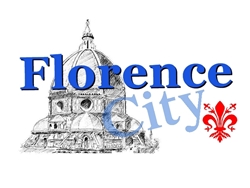![[cml_media_alt id='480']ponte-rubaconte-alinari[/cml_media_alt]](https://www.florencecity.it/wp-content/uploads/2016/09/Ponte-Rubaconte-Alinari-300x154.jpg)
The Rubaconte bridge is the bridge by following the flow of the Arno is just before the Ponte Vecchio. Do not you find? Of course this was his position when it existed, now in its place is the bridge to the Grazie.
The bridge was built in 1237 to join the district of San Niccolò and the Santa Croce district, it was the third bridge built in Florence after the Old Bridge and the bridge Carraia 1218 entirely of wood. A curiosity, the Carraia bridge was called the new bridge and the Old Bridge was called old for that very reason.
In the reality of things the bridge to Rubaconte was the oldest bridge in Florence until 1944 when it was blown up by the retreating Germans. In fact, the first bridge Vecchio did not resist the flood of 1333 Florentine who demolished, while the bridge Rubaconte, more solid, resisted. The old bridge was then rebuilt and then became second for longevity. Former than even the Carraia bridge that went down both in 1269 and in 1333.
It assumes the bridge Rubaconte name because it was built at the behest of the mayor Messer Rubaconte from Mandello. The point of building chosen was the widest point of the Arno River and the day of commencement of the works the same mayor Rubaconte laid the foundation stone stopped by himself with the first mortar. The bridge was built on a design by Jacopo Tedesco, said Lapo attributed to Vasari.
Originally, the bridge had a structure with nine arches, two of these were sacrificed in 1347 to expand the square of the hubs of the Arno and again arch was sacrificed in 1876 to build the embankment Seristori and Torrigiani, reducing it to an end in 6 arches.
In 1273 the bridge represented the meeting point for the two factions of the Guelfi and Ghibellini. In the presence of Pope Gregorio X it was signed a peace but only lasted four days with hostility even worse than before.
![[cml_media_alt id='479']ponte-a-rubaconte-2[/cml_media_alt]](https://www.florencecity.it/wp-content/uploads/2016/09/Ponte-a-Rubaconte-2-300x199.jpg)
The Rubaconte bridge appeared on the pine cones numerous wooden houses, beginning tabernacles then transformed into chapels in 1471, then in dormitories and workshops. The structure that was outlined was similar to that of the Old Bridge, but with the difference that the structures were built only at the poles.
Two of these buildings were oratories, one dedicated to St. Catherine and the other dedicated to the Madonna del Soccorso in which most of the people were devoted to the miracles of which he was author. The people called Santa Maria delle Grazie, hence the name of the bridge that replaced it Rubaconte after World War II, the Ponte alle Grazie, but that’s another story.
![[cml_media_alt id='481']cellette-piloni-alinari[/cml_media_alt]](https://www.florencecity.it/wp-content/uploads/2016/09/Cellette-piloni-alinari.jpg)
Two of these buildings welcomed two female monasteries, one of Romite del Ponte said the Arcangelo Raffaello and the “walled”. The latter housed the nuns since 1320, the nuns who had no contact with the outside. It appears that part of the cells were inside of the pylons, hence the name “walled” This order became very famous very much that the sisters increased making it impossible to host them all nell’esile structure above the deck, for this reason the four were transferred to a monastery in street Ghibellina that it takes its name, it is still the same, of “the walled”. After being a monastery was a prison and now has been upgraded with apartments and meeting places.
In 1876 it was decided to pass the tramway on the bridge, and to get the space you need all the superstructures were demolished, not only the parapets were replaced with cast-iron railings, this radically changed the appearance of the bridge to Rubaconte. The tabernacle of Santa Maria delle Grazie was married in today Lungarno Diaz in an oratory who assumed the name of the saint.
![[cml_media_alt id='483']dante-alighieri[/cml_media_alt]](https://www.florencecity.it/wp-content/uploads/2016/09/Dante-Alighieri-300x200.jpg)
“Come a man destra per salir al monte
dove siede la chiesa che soggioga
la ben guidata sopra Rubaconte
si rompe del montar l’ ardita foga
per le scalee che si fero ad etade
ch’ era sicuro e’l quaderno e la doga”
Translated it means to go to the church of San Miniato al Monte overlooking Florence (well-run … ehehehe) from above you could use the stairs near the bridge to Rubaconte Arno; using the stairs fatigue was minor. It also alludes to the fact that the stairs were made when there was no fraud will falsehoods. (This is the literal translation in the arm 🙂 )
.
Jacopo Cioni
![[cml_media_alt id='32']Jacopo Cioni[/cml_media_alt]](https://www.florencecity.it/wp-content/uploads/2016/09/jacopo-150x150.jpg)

